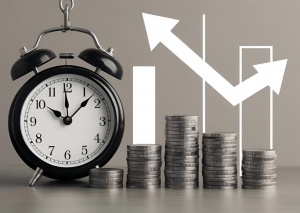When someone borrows money and finds it difficult to repay, they become trapped in a debt trap and take out other loans to pay off their prior obligations. It represents an endless loop in which the debt keeps growing as the borrower continues to take out new loans to pay back previous ones. This can happen often when people utilize personal loans or credit cards to pay for daily expenditures or purchase products without considering how they would pay them back. These loans have increasing interest rates over time, which makes debt repayment more difficult. The individual may wind up paying more interest than they initially borrowed, endangering their financial future and causing severe economic hardship.
A debt trap can have serious financial repercussions, such as debt load, stress, loss of assets and savings, harm to one’s credit score, mental and emotional distress, and restricted financial independence.

People who are in a debt trap are always under pressure to manage rising interest rates and repay loans, which frequently results in them taking out new loans to pay off previous ones. This might make it more difficult to get out of debt.
Consequences of Falling into a Debt Trap
Since lenders consider people with low credit scores to be high-risk borrowers, they may find it difficult to get future loans. Restrictions may be placed on financial prospects, such as starting a business or purchasing a home. When debt mounts, a person may have to sell valued assets or utilize savings to pay back the loans, erasing years of hard-earned earnings and rendering them with limited future financial stability.
Constantly worrying about debt repayment may lead to mental and emotional stress, which can impact relationships, general health, and the quality of one’s employment. Spending less, putting off life ambitions, and losing out on opportunities because of debt repayment obligations can all lead to limited financial freedom.
It is important to establish an emergency fund to avoid these debt traps.
Building an Emergency Fund
Establishing an emergency fund is crucial for both financial and personal security, but it may be an intimidating endeavor. Maximize your savings initially by putting aside a percentage of your salary before paying for other bills like living costs, rent or a mortgage, and auto payments. This strategy promotes long-term development through compounding, guarantees constant saving, and fortifies financial discipline.
Financial security enables a more precise and dependable debt management plan. This consistency guarantees that the debt repayment schedule remains on course by enabling regular debt payments even in the face of unforeseen costs. Additionally, by enabling people to manage unforeseen costs without the need for debt consolidation, an emergency fund lessens the need for debt consolidation of debts and saves money on extra expenses and interest. This makes it possible to pay off debt more quickly and prevents delays or setbacks brought on by unforeseen expenses. All things considered, an emergency fund is a useful instrument for debt management research.
Setting Goals and Growing Your Fund
Assess your monthly costs, such as rent, utilities, groceries, insurance, and loan payments, to determine your emergency fund objective. Set attainable objectives that will not place an unnecessary strain on your finances. The amount of your optimal emergency fund is determined by several variables, including risk tolerance, employment stability, and monthly costs. Try to budget for living expenditures for at least three to six months. People who work for themselves, have less steady jobs, or have inconsistent earnings can benefit from a bigger fund that can cover up to nine months’ worth of costs.
Set aside additional money for your emergency fund by creating a budget. Find ways to reduce the things you enjoy spending on and put the money you save into your fund. Save as much money as you can, even if it means temporarily forgoing things that aren’t essential.

Where to Keep Your Emergency Fund
To guarantee consistent deposits to your emergency fund, automate your savings. To make saving easier, set up automatic payments from your salary to your emergency fund. Take advantage of any bonuses or windfalls that come your way, such as tax returns, work bonuses, or cash gifts, and set aside some of these unforeseen sums for your emergency fund.
An emergency fund should be conveniently available but not so readily accessible that it’s tempting to spend on non-emergencies. A Certificate of Deposit (CD), a money market account, or a high-yield savings account are all excellent choices for putting emergency funds away. High-yield savings accounts, which provide greater interest rates and convenient internet access, are distinct from standard checking accounts. Access to money market accounts is simple and comes with the ability to write checks. Certificates of Deposits (CDs) provide greater interest rates but may not be appropriate for a whole emergency fund owing to early withdrawal penalties.
Final Thoughts on Risk and Balance
Utilize the chance to separate your emergency fund into two categories: short-term emergency funds, which you use immediately in an emergency, and long-term emergency funds, which you preserve for major catastrophes like natural disasters or unexpected medical crises. While short-term funds give instant accessibility and suit dire circumstances until you access long-term money, long-term funds offer higher interest rates but may require several days to liquidate.
Although it is widely accepted that everyone needs an emergency fund, there is disagreement on almost every other aspect of the topic. The emergency fund you have should cover at least three months’ worth of expenses, while experts recommend up to eight.
Some individuals might wonder if it is better to invest your money or keep it in a savings or checking account. The amount of danger that many people discuss is exaggerated, but it depends on how much risk you can tolerate.
You don’t have to decide between letting your emergency money lose value in a low-yield savings account or risking it on stocks. Instead, strike a balance by distributing your money between certain low-risk assets for growth and a high-yield savings account for protection. This allows you to keep up with inflation while keeping your money available for emergencies.





